Maltese Paw Issues:Paw Licking or Chewing, Acute Injury, Chronic Problems
Buddy, at 10 years old,
photo courtesy of Juanita Kocanda
Overview
There are quite a few issues that can develop with a Maltese’s paws, and these may worsen at certain times of the year, or may be an ongoing, chronic year-round problem for both puppies and dogs.
A majority of paw issues are due to an irritation (itching or discomfort). This will cause a dog to bite, which is a canine’s method of scratching, and/or lick, as it is instinct for a dog to lick his wounds. Certain enzymes in a dog’s saliva work to destroy some types of bacteria and licking stimulates blood flow, which, in general, can promote healing.
This said, licking is often more detrimental than it is beneficial, and excessive licking of the paws often makes things much worse.
You may have tried several methods to stop your Maltese from licking or chewing at his paws, with limited or temporary success.
Fortunately, it is possible to effective resolve both acute and chronic paw issues, including those that cause a Maltese to obsessively lick or gnaw at the paws, ankles, and/or toes. This section will cover all of the details, including top acute causes, top chronic causes, and treatment for each.
Please note:
PetMaltese is reader-supported. Some of the product suggestions on this page are affiliate links. As an Amazon Associate we earn from qualifying purchases. This is at no extra cost to you and helps us continue creating useful content.
Already know exactly why your Maltese is licking or chewing at his paws, have already worked to resolve that issue, and are just looking for anti-itch or healing treatment?
Jump ahead to: Step 2: Treat Paw Issues.
Stopping a Maltese from Paw Licking, Chewing is a 2-Part Method
As with many health or behavioral issues, you’ll need to be very thorough in order to truly resolve the problem. There are quite a few reasons why a dog will continually tend to his paws, and we’ll cover all of these ahead. Some are acute and easily resolved. But, in many cases, you will need to both:
1. Identify the trigger and work to limit or eliminate it
– Many times, it will be itching, irritation, or pain that causes a Maltese to lick or nibble at his paws, and the reasons for these conditions can change over time. In addition, there may be more than issue happening simultaneously.
So, it will be helpful to go over possible triggers, checking them off as you go. Once you have one or more suspected culprits, it’ll be time to work to reduce or eliminate those elements. If not, treatment may only be very limited and/or temporary.
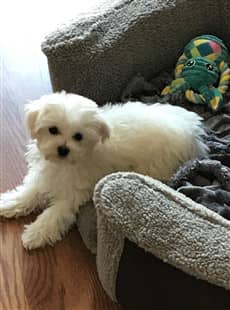
Cooper, photo courtesy of Tracy
Even very effective soothing or healing products for paws can only work to a certain degree if the irritant is still there.
2. Treat the paws
– If the paws are dry, peeling, cracked, damaged, or excessively itchy, treatment may be needed. This includes an anti-itch spray to stop the need to chew the paws and/or a soothing lotion or wax to heal irritation or damage.
These sorts of products are often needed as a second step, because the paws are sensitive areas, with daily contact pressure, and it can take a long time for paws to heal on their own.
Step 1: Identify Why a Maltese is Licking and/or Chewing the Paws & Work to Resolve That Element
Acute Paw Issues
It’s always a good idea to first look to acute causes, which revolves around injury to the paw(s). Some of these would more commonly affect all four paws, though a Maltese may only lick at the front since they are easier to reach. And other acute issues would mainly affect just one paw.
1. Burns
– Any walking surface that is 125 F or hotter can cause burns and damage to the paw pads. At 140 F, burns and permanent scaring to unprotected paws will be suffered after just 1 minute of contact. Hot surfaces between 115 and 120 F can, over time, cause severe drying and a gradual peeling down of the top layer of paw skin.
Liberty Home and Pet Services did a helpful study to test just how hot walking surfaces can be for dogs. This was done in Florida over the course of several days, though these findings are believed to be similar for over half of the states in the US during the summertime. Keep in mind the 125 F threshold.
On a 95-degree day, red brick reached 125 F at noon, blacktop pavement hit 130 F at noon, and cement reached 125 F by 2 PM. The pavement hit a whopping 140 at 2 PM and did not cool down to a safe 110 F until 6 PM. So, all three of these walking surfaces were hot enough to burn a dog’s paws.
Signs of this:
Limping or favoring a paw(s), licking or chewing at the paw(s), darkening of the skin on or surrounding the paw pads, peeling, blisters, or red areas.
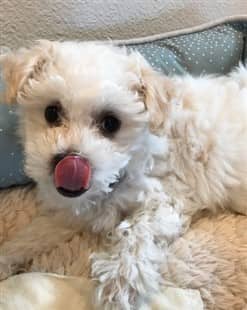
What to do:
If you notice this while your Maltese is still outside, pick your dog up and carry him into the house. Run cool water over the paws for 10 minutes. Gently press a cold compress on the burns.
While minor burns may be able to be treated at home with dabs of an antibiotic ointment, it is best to call the veterinarian; Burns can be evaluated for 1st, 2nd, or 3rd degree damage, can be treated with antibiotics (topical and/or oral), and wrapped.
Prevention:
If you cannot keep the back of your hand on the pavement for a count of 5, it is too hot for your Maltese to walk on. Use a quality paw wax to add a layer of protection (details ahead under: Step 2: Treat Paw Issues). On hot days, take walks before 10 AM and after 5 PM and/or stay in the shade and/or on grass if possible.
2. Bee sting, insect bite
– Many types of stinging insects may be at ground level; and some, like the Ground Digger Wasp, as the name implies, nest into the ground. Red ants are also a possibility. So, it’s not uncommon for a dog to be bit or stung on a paw.
Signs of this:
There will be localized swelling and tenderness at the site. You may or may not see a stinger.
What to do:
If you see a stinger, scrape it out using the edge of a credit card; do not try to pull it out with tweezers, since doing so can release more venom. If it was a bee that stung the paw(s), a paste made of baking soda and water may help soothe the sting. A cold compress may help no matter the type of insect.
Keep an eye out for an allergic reaction to the venom; signs include hives, swelling around the eyes or on the face, drooling, and/or trouble breathing. This is considered to be an emergency situation, call the vet ASAP.
3. Splinter
– Dogs can easily get splinters in their paws when walking outside; though splinters will often not be able to break through the actual paw pads, they can easily pierce the skin between the pads.

Sheldon, at 1 and 1/2 years old,
photo courtesy of Emmy
Signs of this:
Typically, a splinter will be in just one paw, so a dog will suddenly start limping, favoring, or licking at just one particular paw. A splinter may not be easily visible, depending on the angle at which it entered.
What to do:
For stretched skin, this will usually resolve itself within a day or so, as long as the area is not further disturbed. For tears to the skin, it will be a judgement call to treat this at home or have the vet take a look, depending on the severity.
From home, you can use a 1:1 ratio of Betadine First Aid Antiseptic Solution
 to wash the area, and then dab the area with betadine using a sterile cotton ball. To allow the area to heal, you’ll need to prevent your Maltese from licking at it; you can slip on a doggie sock or use self-adhesive tape to cover the paw.
to wash the area, and then dab the area with betadine using a sterile cotton ball. To allow the area to heal, you’ll need to prevent your Maltese from licking at it; you can slip on a doggie sock or use self-adhesive tape to cover the paw.
Prevention:
A quality paw wax is recommended year -round, and winter is no exception (details ahead under: Step 2: Treat Paw Issues). A good one will protect a Maltese from this wintertime worry, and also offer a barrier from ice-melt chemicals and/or frozen walking surfaces.
Chronic Paw Issues

While it was necessary to cover acute issues, many of your will be looking for help for a Maltese that has an ongoing, chronic issue with licking the paws or toes. And, this is where it will be very important to take the time to assess and rule out every possible cause.
In addition, each cause has multiple steps to resolving it, and each should be followed to the best of your ability.
After all, while it may seem frustrating to you that your Maltese can’t stop licking his paws, it is just even more bothersome to the puppy or dog, and it’s time for your Maltese to start feeling better.
1. Stress
– While most paw licking or chewing can be traced to an irritant, some dogs lick their paws as a soothing mechanism to deal with stress.
Often, boredom is very emotionally stressful for dogs; and this can develop even if owners are home, but are too busy to spend adequate time with their dog. In other cases, being home alone can trigger moderate to severe separation anxiety; and licking areas of the body, such as the paws, may be a reaction to that stress.
Other triggers may include a chaotic household, or changes in the family dynamic such as a new person or pet moving in, or the loss of a loved one.
What to do:
1) Resolution of the trigger.
Maltese that are overly bored
need to have two things: A fuller schedule and the means to keep themselves occupied.
Be sure to take your Maltese for at least 2, and perhaps 3 walks per day. Once a week, take your dog to explore a new area such as a new dog park or a visit to a pet supply store. Work on commands, or play games together.
If there are other family members that are not very involved in spending time with your Maltese, now may be the time to remind them how rewarding it can be to brighten up a dog’s day with some interaction.
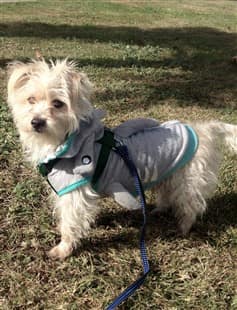
Hank, at 3 years old,
photo courtesy of Jacki Proctor
That said, even the most loving, diligent owners only have so much time in the day; and this is where certain toys can really help. Those that react to a dog’s motion, speak, make funny sounds, or otherwise interact with a dog can be great ways to keep a dog busy (more details right below).
Maltese that have separation anxiety, can be helped in a multitude of ways. Methods to help with separation anxiety
include:
1 -
Creating a secure and safe ‘den’. Crates can be terribly confining; but, a playpen like the IRIS Playpen with a Door , is a great way to create a structured area that dogs instinctively acknowledge as ‘dens’, thus offering comfort and calming. This also helps keep all of a Maltese’s belongings (toys, food, bed, pee pads, etc.) in one area.
, is a great way to create a structured area that dogs instinctively acknowledge as ‘dens’, thus offering comfort and calming. This also helps keep all of a Maltese’s belongings (toys, food, bed, pee pads, etc.) in one area.
2 -
Playing calming music. Streaming relaxing music can make a big difference. If you’re not sure what your Maltese would like, there is music created specifically for canines, like Music Dogs Love: While You Are Gone .
.
3 -
Using an interactive pet cam to speak to your Maltese and dispense treats from far away. While it is not for everyone’s budget, the Petzi Pet Cam and Treat Dispenser
 has a speaker, a live-cam for you to see your dog, and it lets you send out treats with a quick tap on your smartphone.
has a speaker, a live-cam for you to see your dog, and it lets you send out treats with a quick tap on your smartphone.
4 -
Making sure that your dog has at least a couple of interactive toys. Those that react to a dog’s movements with speech or funny sounds make a dog believe that the toy is truly playing with them. One of our favorites is the Babble Ball .
.
5 -
Offering a companion toy. These are meant to mimic living creatures. And with a rhythmic, beating heart, and soothing warmth, a Smart Pet Love Snuggle Puppy
 comes as close as you can to getting another dog without actually doing so.
comes as close as you can to getting another dog without actually doing so.
Maltese that are stressed due to commotion
in the house will appreciate a calmer atmosphere, and for the times that that is not possible, a quiet corner to retreat to. Be sure that this is not too isolated, as that would cause stress as well. But, a bed that is away from foot traffic and loud noises is always appreciated.
Changes to the family
do take some time to get used to. With the addition of a new pet, try to give both animals their own private spaces for eating, playing, and sleeping. Supervise them to ensure there is no rough play. With the loss of a family member, time is the best cure. However, having new surroundings (the beach, a new ‘easy’ hike trail, etc.) to offer new sights, smells, and sounds, can help perk up a dog.
2) Treatment
As you work to make changes to resolve stressful situations, you’ll also want to treat the paws to clear up any existing issues. More is ahead in Step 2: Treat Paw Issues.
2. Environment related dry or cracked paws
– Between walking on different surfaces (hot, cold, rough, rocky, grassy), paws need to stand up to a lot.
When you add irritants to this (ice melt in the winter, heat in the summer, small pebbles, lawn chemicals, etc.) and weather-related aspects such as arid air, this can be a recipe for dry paws. If drying on the paws is not resolved, this can spiral into cracking rather quickly.
What to do:
1) Work to resolve elements that cause damage and/or dryness.
- When walking your Maltese on surfaces that are new (for example, rocky paths), start with short sessions, and work your way up.
- Protect the paws against heat, cold, pebbles, ice, and other outdoor elements. This can be done by using paw wax (more ahead).
- It can also help to encourage your Maltese stay properly hydrated; you’ll want to keep the bowl clean, keep water cool and fresh, and bring along water for your dog to drink when out on walks.
- In the winter, when air is typically very arid, it can help to set up humidifiers in the house to combat dry skin.
- As always, use a top-quality shampoo
with soothing ingredients like oatmeal and/or aloe that helps prevent dry skin.
2) Treatment
Treatment may include a spray for itching, a wax to protect, and/or a cream to heal peeling, drying, cracking, or other damage. Much more is ahead in Step 2: Treat Paw Issues.
3. Yeast infection
– Some degree of yeast (fungi) is always present on a dog’s skin. However, it can start to reproduce in greater than normal quantities, in certain areas, and under certain conditions.
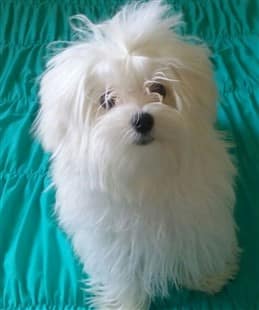
What to do:
If your Maltese has a yeast infection on the paws, there are two steps to fixing this; give baths with a medicated anti-fungal shampoo and apply a medicated anti-fungal topical (spray or cream) to the area.
One of the most effective antifungal medications for dogs is ketoconazole. This can be applied topically (shampoo, cream, gel, spray) or orally (Nizoral, Ketochlor). Oral ketoconazole must be prescribed by the veterinarian, and is needed in cases of very stubborn yeast infections that do not respond to the topicals.
About the shampoo
– While just a topical cream or spray may work, baths with antifungal medicated shampoos are opportunity to soak every nook and cranny on the paws, and this can go a long way in curing things.
Recommendations:
We recommend Curaseb Antifungal & Antibacterial Shampoo , this is prescription strength with 1% ketoconazole, has a nice fresh scent (cucumber melon), and is made in the USA. This also contains chlorhexidine gluconate (2%), which is an antibacterial. With this combination, this shampoo can resolve a wide range of skin infections.
, this is prescription strength with 1% ketoconazole, has a nice fresh scent (cucumber melon), and is made in the USA. This also contains chlorhexidine gluconate (2%), which is an antibacterial. With this combination, this shampoo can resolve a wide range of skin infections.
Use:
This is typically used twice per week. You’ll want to massage this in well, and let it soak in for 10 minutes. Since symptoms can resolve before the fungal infection is completely gone, you may want to do one more bath after signs are no longer apparent.
About the topical spray or cream
–While baths with an antifungal shampoo will allow your Maltese’s paws to get nice thorough soakings, another part of this is to offer daily, round-the-clock treatment.
Recommendations:
We recommend a spray since it is every easy to apply, and for Maltese whose paws are sensitive, this allows a no-touch application.
One recommended paw spray is Curaseb Chlorhexidine Spray with Aloe
 (the same manufacturer as the aforementioned shampoo). It has 1% ketoconazole and 2% chlorhexidine gluconate, but also contains aloe which helps with itching and to heal the area round-the-clock.
(the same manufacturer as the aforementioned shampoo). It has 1% ketoconazole and 2% chlorhexidine gluconate, but also contains aloe which helps with itching and to heal the area round-the-clock.
Another is SynergyLabs Veterinary Formula Antiseptic & Antifungal Spray ; this has chlorhexidine gluconate and both lanolin and aloe vera, both of which works to combat dry, itchy, or irritated skin.
; this has chlorhexidine gluconate and both lanolin and aloe vera, both of which works to combat dry, itchy, or irritated skin.
Use:
Spray the paws 3 times per day, and continue using this 5 to 7 days passed the date that the paws seem to be completely fixed. Note that this can resolve yeast infections on paws as quickly as 4 to 5 days.
The last application should be at night, right as your Maltese is falling asleep.
To stop your Maltese from licking this off, you’ll want to prevent licking for 1 hour as the product dries.
You can use a cone like the All Four Paws Comfy Cone , which has easy Velcro fastening, is padded for comfort, and is available in extra-small and small. Alternatively, you can slip socks over your Maltese’s paws; if you use socks, take these off after that first hour.
, which has easy Velcro fastening, is padded for comfort, and is available in extra-small and small. Alternatively, you can slip socks over your Maltese’s paws; if you use socks, take these off after that first hour.
4. Allergies
– If your Maltese is licking, biting, or chewing at the paws, a major leading cause is itchiness due to allergies. It may be food, environmental (seasonal), or contact allergies, with both food and seasonal being the top culprits.
Signs:
In some cases, itchy paws are the only symptom. In other cases, it is one of the first symptoms, with more to follow. And for other dogs, it is seen alongside other signs including rash, hot spots, dry skin, itchiness on other areas of the body, thinning hair (in places where a dog licks or chew at), wheezing, coughing, runny nose, and/or irritated eyes.
What to do:

1) Work to reduce or eliminate allergens.
There are tests (ELISA blood test or intradermal skin test) that the veterinarian can perform to help pinpoint triggers; while these are not 100% accurate, you may want to discuss this with your vet.
With or without allergy testing, you’ll want to clear the house and your Maltese of as many allergens as you can. Here are 10 tips to help a Maltese with allergies:
1. Vacuum the entire house (all flooring surfaces) with a vacuum cleaner that uses HEPA filtration.
2. Clean the air via a central air system with HEPA filters or using stand-alone air purifiers with HEPA filtration.
3. Wet-dust the house.
4. Wash all bedding, pillowcases, dog bed covers, etc. in hot water (at least 140 F).
5. Once the house is cleared, keep windows closed.
7. Each time your Maltese enters back inside, wipe the coat down with hypo-allergenic wipes like
Earthbath All Natural Grooming Wipes
 and rinse the paws off in the sink.
and rinse the paws off in the sink.
8. On high pollen days, avoid taking your Maltese out during the middle part of the day when pollen is at its peak.
9. Feed your Maltese a 100% all-natural kibble that has ZERO grains, corn, soy, wheat, chemical preservatives, artificial flavoring, or by-products. Wellness CORE Natural Grain-Free for Small Breeds
 is a great choice.
is a great choice.
10. Do not use plastic bowls. Stainless-steel or ceramic is best.
2) Treatment
While you are working to reduce triggers that are making the paws itchy, there are remedies that can offer immediate relief. We will discuss these next.
Step 2: Treat Paw Issues
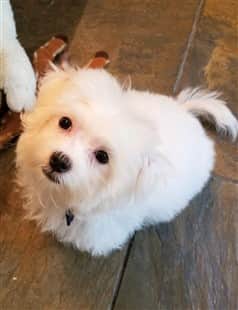
There are some great treatments for paw issues, and these will work best when used concurrently with resolving the underlying causes. If the trigger(s) of a paw problem (allergies, etc.) is not fixed, results with these remedies will be limited, as you will be fighting an uphill battle.
Let’s see what can help, depending on exactly what is happening with your Maltese.
Paw wax.
A quality paw wax can do quite a bit. It will protect the paws from heat, cold, snowballing, rough surfaces, and drying. It can also help heal overly dry paws.
Our top recommended paw wax may be no surprise, it is one of the most well-known out there; Musher's Secret Paw Wax . This creates a super-protective barrier while allowing the paws to breathe, and offers vitamin E to moisturize and help heal minor problems.
. This creates a super-protective barrier while allowing the paws to breathe, and offers vitamin E to moisturize and help heal minor problems.
For prevention of paw issues, apply this to your Maltese’s paws every 7 days. This absorbs within 1 to 2 minutes, and you can double-check by applying a small dab to the back of your hand at the same time that you massage this into your Maltese’s paw pads; when it has absorbed into your skin, it has also done so on the paws.
Healing cream.
To treat excessively dry paws, peeling, and/or minor to moderate cracking, a restorative cream is a good option. We really like ResQ Organics Pet Skin Treatment . This also works very effectively on a host of issues aside from damaged paws, including skin sores, nose issues, itchy skin all over, and can even reverse thinning hair issues.
. This also works very effectively on a host of issues aside from damaged paws, including skin sores, nose issues, itchy skin all over, and can even reverse thinning hair issues.
It is so good at healing due to its luscious blend of all organic ingredients including aloe vera, Manuka honey, coconut oil, olive oil, hemp seed oil, shea butter, cehami (an extract from an Australian daisy flower), blue-green algae, and vitamins A, B, C, and E.
This can be massaged into the paws 1 to 2 times per day, and you may see results in as little as 3 days.
Anti-itch spray.
If your Maltese has itchy paws, you can offer immediate relief with an effective anti-itch spray. Since licking or biting in response to the itch is a major problem as well, and you won't want your Maltese licking up strong medications like hydrocortisone, we recommend an all-natural spray that is non-toxic.
A great one to try is Bodhi Dog's Anti Itch Oatmeal Spray . This can relieve itching right away with its blend of colloidal oatmeal, baking soda, wheat germ, and Vitamins A, E, and E.
. This can relieve itching right away with its blend of colloidal oatmeal, baking soda, wheat germ, and Vitamins A, E, and E.
When to See the Vet
Do not hesitate to bring your Maltese to the veterinarian any time that you do not feel comfortable diagnosing or treating issues from home.
Additionally, if you’ve followed all of the guidelines here but still cannot pinpoint the reason for your puppy or dog’s paw issues, and/or if you’ve tried all available home remedies but there is no improvement, a vet visit will be warranted.
Severe cracking, and particularly if there is bleeding and/or pus-like discharge, is also a reason to see the veterinarian. Antibiotics and other veterinary treatment may be needed
Are You a Member Yet?
Become a free PetMaltese Member
- This will allow you to receive a friendly reminder when new pages of Maltese info are added to the site. You will also be able to submit photos of your adorable Maltese to be added here, and be able to suggest a topic for us to write about.
Spotlight Article
There are 5 steps to keep a Maltese ultra white, while maintaining excellent skin and coat health.

-min-450x169-1920w.jpg)
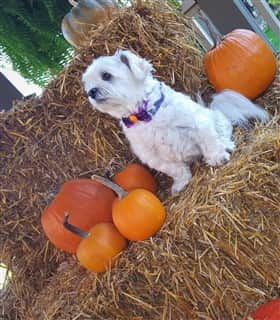
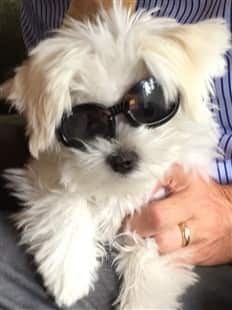
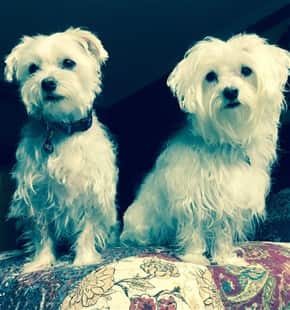


-min-180x187-1920w.jpg)